Archive for the 'Content Type' Category
Posted by James (admin) on 3rd September 2012
More games to watch out for at Spiel. (I’ve combined all the Spiel games on my radar on my Essen 2012 page.)
Phantom (Ludonaute)
A 2-player game announced today by Ludonaute who say some people call Phantom a mixture of ‘Lost Cities’ with elements of ‘Magic: The Gathering’. That’s a lot to live up to and I really hope it does as there have been few great 2-player games in recent years. The game has players playing two restless ghosts in a house trying to scare the current occupants more than the other player by creating apparitions in the 4 areas of the house. It sounds really interesting.
Check out the details and rules at Ludonaute’s web site: bga.me/phantom
La Loire (Emanuele Ornella)
I like Emanuele Ornella’s games (Il Principe, Charon Inc, Assyria) so I am looking forwards to his new one. Players move merchants and messengers around the Loire Valley with an interesting game mechanic where they have to move the number of spaces equal to the number of horses with the piece being moved (and this number can change). The location a piece ends on dictates the action the player can take, like buy or deliver messages, buying goods, build buildings, move their ship down the river, etc. (If you’ve read this blog for a while, I interviewed him some time back.)
Check out the details and rules on Ornella’s web site: bga.me/loire
Nieuw Amsterdam (White Goblin)
A game of buying land, gathering wood and corn, buying furs, and shipping for profit. Whilst that may sound fairly regular, there are some neat game mechanics that make it sound like it’ll feel different to other games. The core mechanic is that players bid on sets of actions and the each type of action can be used for a few different effects. Also, timing clearing your land to gather wood is important, and you can’t grow corn there unit you do. Plus, there’s some area control too which gives you an advantage when using special actions rather than outright ownership of them which appears a nice balance. Also, the setting of New Amsterdam (Old New York) is nicely original. (How long before we can all agree that New York is longer new and can just be called York?)
Check out the details and rules at White Goblin’s web site: bga.me/NieuwAms
Clash of Cultures (Z-Man Games)
A civilisation game by the designer is the excellent Merchants and Marauders. I know little more than that at present but that has me sold already.
Pyramidion (White Goblin)
White Goblin has two Egyptian-themed games this year and Pyramidion sounds interesting. One of the 8 locations is selected and players allocate some of their people (cards) to it and each card has 3 characteristics (numbers). If a player’s group doesn’t have enough of the first characteristic, they all get discarded. Players with the highest totals of the second and third characteristics get various benefits. Also, who doesn’t like a game with Merchants, Negotiators and Torturers??
Check out the details and rules at White Goblin’s web site: bga.me/pyramidion
Tags: board game news, Board Games, board gaming, Clash of Cultures, Essen, La Loire, Nieuw Amsterdam, Phantom, Pyramidion, Spiel 2012
Posted in Board Games, Clash of Cultures, Essen Spiel 12, La Loire, Nieuw Amsterdam, On the Radar, Phantom, Pyramidion | No Comments »
Posted by James (admin) on 2nd September 2012
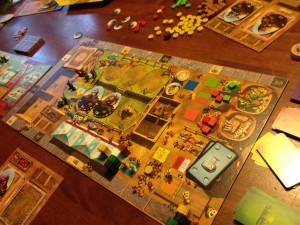 Dungeon Petz is by the same designer as Dungeon Lords and shares other traits like the same art style and same imp figures. However, Dungeon Petz is a totally separate game. During the game, players are trying to raise various strange creatures and score prestige points (PP) by having the best creatures in pet shows and by selling them too. Player with the most PPs at the end of 5 rounds wins.
Dungeon Petz is by the same designer as Dungeon Lords and shares other traits like the same art style and same imp figures. However, Dungeon Petz is a totally separate game. During the game, players are trying to raise various strange creatures and score prestige points (PP) by having the best creatures in pet shows and by selling them too. Player with the most PPs at the end of 5 rounds wins.
GAMEPLAY
Each player starts with a player board which has one basic cage on it and room for 3 more. Each round, players use their imps to get new pets, new cages, cage improvements, pet food, extra imps, as well as do a few other actions which I’ll mention later. The core mechanic for the game is worker placement as players use their imps to claim actions, but there is a nice twist to make it different to most worker placement games. In Dungeon Petz, players form their imps (and gold) into groups behind a screen. They then reveal their groups and the groups of the biggest size take their actions first. So, players can put all their imps in one basket so-to-speak to ensure they claim one action before anyone else, or they can put them in smaller groups to claim multiple actions but the smaller the group, the greater the risk that another player will have taken that action first. Read the rest of this entry »
Tags: board game news, Board Games, board gaming, Dungoen Petz
Posted in Board Game Review, Board Games, Dungeon Petz | No Comments »
Posted by James (admin) on 1st September 2012
K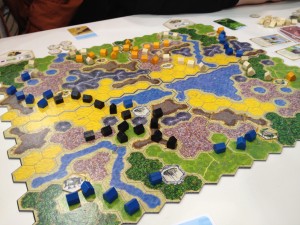 ingdom Builder is designed by the designer of Dominion and went on to win the coveted Spiel des Jahres award 2012. The game is relatively simple. Players score points at the end of the game based on where they have built their buildings based on criteria specified by 3 Kingdom Builder cards (randomly selected from 10). The board is created using 4 sections in any combination (randomly selected from 8).
ingdom Builder is designed by the designer of Dominion and went on to win the coveted Spiel des Jahres award 2012. The game is relatively simple. Players score points at the end of the game based on where they have built their buildings based on criteria specified by 3 Kingdom Builder cards (randomly selected from 10). The board is created using 4 sections in any combination (randomly selected from 8).
On their turn, a player has just one terrain card and they must place 3 of their buildings on unoccupied spaces on the board that match that terrain type. Buildings must be placed next to any of the player’s existing buildings, if possible; otherwise, they can be placed on any hexes of the matching terrain. If the player places any of their buildings next to one of the special locations on the board, they get to take one of the matching special action tiles.
As well as the mandatory action, players can use any special actions they have collected which allow a player to do things like moving buildings and building an extra buildings. The special actions can each be used once per turn. Read the rest of this entry »
Tags: board game news, Board Games, board gaming, Kingdom Builder, Spiel des Jahres
Posted in Board Game Review, Board Games, Kingdom Builder | No Comments »
Posted by James (admin) on 31st August 2012
Here are some more games for Essen that have caught my attention:
Libertalia (Paolo Mori / Marabunta)
Vasco de Gama is an excellent game so I was intrigued to see what Libertalia was like as it’s by the same designer. Players blind bid cards to win tokens which determine victory points. Each player has the same deck of cards to bid with but a random set is drawn for each round by one player and the other players use the same mix of cards – so the players’ hands are the same each round.
Check out more info here: bga.me/libertalia
Tokaido (Bazua / FunForge)
It looks clean and simple, and sounds like it will play the same too. Players move along a straight road and can rush ahead to secure places before other do, but at the expense of missing out other locations where points could be earned. Reminds me a bit of the worker placement in Egizia (which was really good). Also, I’ve always been impressed with FunForge’s production quality.
Check out more info here: bga.me/tokaido
Lyssan (Thornhenge)
This game got my attention when it was on Kickstarter last year. Sadly, I never managed to get to play the print-and-play version, but the game sounds simple but with meat to it. Players place knights, nobles, priests, etc. to try and achieve their objectives.
Check out more info here: bga.me/lyssan
Milestones (Stefan Dorra / Eggertspiele)
Intriguing game mechanic of rondel-style play mixed with building and resources. The rondels are the players’ boards and these change during the game as the player builds locations and others disappear as the player completes circuits. So, a little element of the excellent Village in there too.
Check out more info here: bga.me/milestones
Expedition (White Goblin)
Intriguing mixture of game mechanics combining area control, bidding, and card combination as players travel from stop-to-stop along the Congo River in 1884. Seems to be all about using the right character at the right location with the right additional support cards.
Check out more info here: bga.me/expedition
Maharani (Wolfgang Panning / Queen Games)
A game by the designer of Fresco which looks to combine area control, but with some other mechanisms too. Looks clean and simple – hopefully has some good decisions although I’m not sure how deep it is yet. Nice friendly theme of tiling the floor of the Taj Mahal.
Check out more info here: bga.me/maharani
More new releases for Essen to come. I’ve combined all the games on my radar for Spiel on the Essen 2012 page.
Tags: board game news, Board Games, board gaming, Essen, Expedition, Libertalia, Lyssan, Maharani, Milestones, Spiel 2012, Stefan Dorra, Stefan Feld, Tokaido
Posted in Board Games, Expedition, Lyssan, Maharani, Milestones, On the Radar, Tokaido | No Comments »
Posted by James (admin) on 30th August 2012
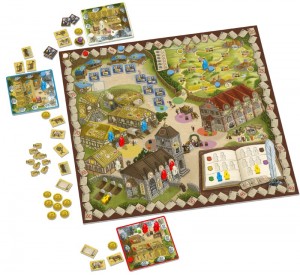
I read the rules for Village when I was at Essen last year and as soon as I saw the meeple laying in the history book or in the unmarked graves I knew I wanted to play it. I pre-ordered it and I’m glad I did as I’ve really enjoyed every game I’ve played of it so far. More recently it rightly won the complex Spiel des Jahres award too. The reason it’s a great game is due to an interesting mix of some unusual game mechanics – none are complex but there’s lots of variety – so I shall attempt to summarise the main elements.
GAME OVERVIEW
In Village, players use their villagers (meeple) to do various tasks and the goal is to earn the most respect (victory points – VPs). There are two key mechanisms in the game – time and actions.
Time
The first core mechanism is time – many actions use up time which each player tracks with a marker around the edge of their player board (their farm). Quite often, the player has a choice to spend time or use resources to do things like making a plough, but many options require time like travelling, or training a craftsman. When the time marker completes a circuit of a player’s board, one of the eldest villagers of that player passes away and is either placed into the history books or in an unmarked grave (more on that later). Read the rest of this entry »
Tags: board game news, Board Games, board gaming, Essen, SdJ, Spiel 11, Spiel des Jahres, Village
Posted in Board Game Review, Board Games, Essen Spiel 11, Village | No Comments »
Posted by James (admin) on 29th August 2012
It seems the Essen pre-hype began even earlier than usual this year with many, many new games being announced for release. It’s interesting to see how many new publishers there are this year too.
I shall be posting about forthcoming games that have caught my attention. As well as posting them, I have also added an Essen 2012 page where I will collate them as I go. Hopefully, I will get a chance to play them at Essen and then review them too.
Here’re the first few:
Bora Bora (Stefan Feld / Alea)
Stefan Feld always seems to find some interesting game mechanic to place at the heart of his games (Trajan, Luna and many others). In Bora Bora, players allocate dice to actions (the higher the number, the greater the effect of the action) and following players can use a previously used action but only with a lower value dice. So, a player could use an action with a low number and get little effect but would know following players would get even less out of that action. Sounds neat (and humorously mean).
Aztlan (Leo Colovini / Ares)
It’s funny how it can take some time to notice you like a specific game designer’s games. This game is designed by Leo Colovini so I checked what else he had done only to discover I have a lot of games by him and I like them too (Atlantis, Masons, Clans, Carolus Magnus). Aztlan sounds interesting too. From what I can tell, players secretly select a terrain type card (which determines where they get advantages) and then start placing meeple into regions for dominance (although can co-exist as well as fight) – players try to get control of areas whilst trying to figure out what terrain cards their opponents’ played so they know where they should pick their battles.
Check out more info on Ares’ site here: bga.me/aztlan
Rattus Cartus (Berg brothers / White Goblin)
I like the Berg brother’s games (Rattus and especially Oregon which is one of my favourite games) and the Rattus card game rules sound like it should be fun with some interesting mechanics that keep the theme and feel of Rattus but without directly duplicating it.
Check out more info on White Goblin site here: bga.me/rattuscartus
Balance of Power (Catalyst Game Labs)
Risk/Diplomacy looking game but using 3 types of unit that work in a rock/paper/scissors style. On a turn a player gets one action with each type of unit and actions are to move, attack or duplicate themself. Points are earned for controlling areas, capitals and your own country. Sounds simple yet tactical and without any luck. (This one just got released in the UK.)
Check out more info on the Catalyst site here: bga.me/balanceofpower
City of Horror (Asmodee)
I really liked Mall of Horror but it was broken as the person who controls the Security Room could hold it and win the game. However, City of Horror is a mjaor re-working of the original game and looks like it will be the game the original one should have been with lots of new game mechanics. Really looking forwards to this one.
Check out more info on the Asmodee site here: bga.me/cityofhorror
Call to Glory (Schacht / White Goblin)
Nice, simple card game. Some push-your-luck element as you lay down sets of matching cards to get points but can’t add to them once they’re down and an opponent can take those points if they can lay down more cards of that type. Players draw from the two draw decks or the two discard decks.
Check out more info on the White Goblin site here: bga.me/ctglory
Tags: Aztlan, board game news, Board Games, board gaming, Bora Bora, BValance of Power, Call to Glory, City of Horror, Essen, Rattus Cartus, Spiel 2012
Posted in Atlantis, Aztlan, Balance of Power, Board Games, Bora Bora, Call to Glory, City of Horror, Essen Spiel 12, Luna, On the Radar, Rattus, Rattus Cartus, Trajan | No Comments »
Posted by James (admin) on 28th August 2012
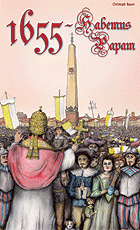 The theme of selecting a new pope may not be as broadly inspiring as that of pirates or city building, but don’t let this put you off as 1655 Habemus Papum is a surprisingly great game.
The theme of selecting a new pope may not be as broadly inspiring as that of pirates or city building, but don’t let this put you off as 1655 Habemus Papum is a surprisingly great game.
Essentially, it’s a bidding game as players blind (simultaneous) bid gems to determine in what order the players will take one of the 4 cards on offer each round. The goal is to be voted pope at the end of the game which you do by collecting votes. You start with a few gems which have a strict hierarchy: diamonds, rubies, sapphires and amber in descending order.
Each round 4 cards are on offer – one from each of the 3 decks plus the start player card. Players secretly put 0-3 gems in their hand and simultaneously reveal. The player with the most gems (any colours) picks a card first, then the player with the next highest total of gems, etc. If players are tied on quantity of gems then the quality of the gems is compared – players compare their most valuable gem, then the next and so on. If players have bid identical gems then the person closest to the start player going clockwise wins the tie.
The cards are cardinals (which give votes and sometimes cash), actions (which let you do things like steal cardinals, or your best gem counts twice for one bid), and political cards (which let you get votes from the King depending upon how many King cards you have, or allow you to buy votes more cheaply at the end of the game depending upon how many of those cards you ave, etc.) The start card is very important too as not only does it mean you win ties but, even more importantly, you get 1 red, 1 blue and 1 yellow gem plus 1 cash – this is the ONLY way you can get more gems during the game. Note you can never get more diamonds. Read the rest of this entry »
Tags: 1655 Habeus Papum, board game news, Board Games, board gaming
Posted in 1655 Habemus Papum, Board Game Review, Board Games | No Comments »
Posted by James (admin) on 24th November 2011
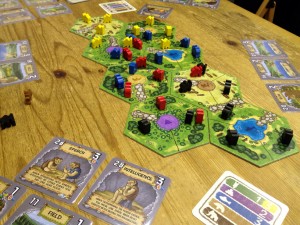 In Power Grid: The First Sparks, players have stone age clans trying to expand into new areas. The First Sparks is a simplified (and differently themed) version of the very popular game Power Grid – I’ll talk about how the two compare at the end but will write this review from the point of view that you haven’t played, or know, Power Grid.
In Power Grid: The First Sparks, players have stone age clans trying to expand into new areas. The First Sparks is a simplified (and differently themed) version of the very popular game Power Grid – I’ll talk about how the two compare at the end but will write this review from the point of view that you haven’t played, or know, Power Grid.
THE GAME
During the game, players need food to feed their clans so they can expand into new territories. Food is gained by clans in areas using tools and knowledge. Food comes in various forms and each token of each type is worth different amounts of food (crops=1, berries=2, fish=3, bears=3, mammoths=4). The board is a landscape of hex zones each with a food type in the centre and split into 3 areas. Read the rest of this entry »
Tags: board game news, Board Games, board gaming, Essen, Power Grid The First Sparks, Spiel 11, Spiel 2011
Posted in Board Game Review, Board Games, Essen Spiel 11, Power Grid The First Sparks | No Comments »
Posted by James (admin) on 22nd November 2011
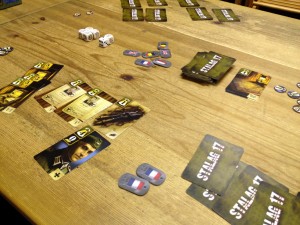 In Stalag 17, players are prisoners of war assembling their escape plans – the first to have all 3 of their POWs escape wins. At the start of each escape attempt, some dice are rolled which determines what equipment (food, uniforms, maps,etc.) will be required for this escape attempt as well as a normal dice (1-6) which is the runaway score that a player needs to equal or beat too.
In Stalag 17, players are prisoners of war assembling their escape plans – the first to have all 3 of their POWs escape wins. At the start of each escape attempt, some dice are rolled which determines what equipment (food, uniforms, maps,etc.) will be required for this escape attempt as well as a normal dice (1-6) which is the runaway score that a player needs to equal or beat too.
Players take turns taking, discarding and placing cards. One their turn a player can:
- Play 1 card from their hand in front of them face-down (taking a replacement card from the draw deck)
- Draw 2 cards (both from the draw deck or 1 from the draw deck and 1 from the discard pile)
- Discard: any 1 card, or 3+ cards that are the same, or 5+ cards that are all different
- Escape Read the rest of this entry »
Tags: board game news, Board Games, board gaming, Essen, Spiel 11, Spiel 2011, Stalag 17
Posted in Board Game Review, Board Games, Essen Spiel 11, Stalag 17 | No Comments »
Posted by James (admin) on 21st November 2011
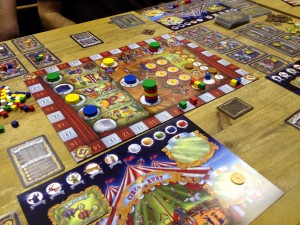 In Drum Roll, players are putting on circus shows with the winner scoring the most prestige points (PPs) after three performances.
In Drum Roll, players are putting on circus shows with the winner scoring the most prestige points (PPs) after three performances.
To score PPs, players need to hire performers (which costs cash) and give them the enough equipment, costume, etc. (represented by colour cubes) so that they can give great performances. Each performer can give a 1-, 2- or 3-star performance; however, each performer needs a specific colour cube for each level of performance – so a 3-star performance requires 3 cubes of the exact colours. Each of the 5 types of performer give different benefits (gaining cubes, generating cash, reducing salaries, etc.) and the better the performance, the better the ability. Instead of delivering their 3-star performance benefit though, the player can flip that performer’s card which earns PPs (and reduces their salary each round) but means they player can not use their ability any longer. Read the rest of this entry »
Tags: board game news, Board Games, board gaming, Drum Roll, Essen, Spiel 11, Spiel 2011
Posted in Board Game Review, Board Games, Drum Roll, Essen Spiel 11 | No Comments »





 The theme of selecting a new pope may not be as broadly inspiring as that of pirates or city building, but don’t let this put you off as 1655 Habemus Papum is a surprisingly great game.
The theme of selecting a new pope may not be as broadly inspiring as that of pirates or city building, but don’t let this put you off as 1655 Habemus Papum is a surprisingly great game.

